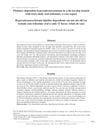Clinical and Imagistic Aspects in Dog’s Hyperadrenocorticism Determined by Pituitary and Adrenal Nodules with Secretory Function
TLDR Most dogs with Cushing's syndrome have pituitary tumors causing varied symptoms, complicating diagnosis.
The study discussed pituitary-dependent hyperadrenocorticism (PDH) as the most common cause of Cushing's syndrome in dogs, with functional ACTH hormone-secreting tumors found in approximately 85% of affected dogs upon necropsy. PDH often led to concurrent clinical diseases, complicating diagnosis due to non-specific symptoms such as diabetes, ascites, nervous symptoms, chronic skin disease, bilateral hair loss, urinary incontinence, liver disease, or low back pains. The episodic nature of excessive ACTH and cortisol secretion resulted in fluctuations that could temporarily normalize serum levels, potentially leading to negative results in ACTH stimulation and dexamethasone suppression tests.





